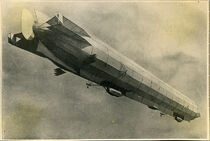| FCT Mk. II | |
|---|---|

| |
Class Overview
| |
| Place of Origin | Fanaglia |
| Operators | Fanaglia, Patisserie-Goulash, Hacha Hatak |
| Designer | Monty Anderson |
| Manufacturer | Fanaglian Central Textiles, Aerospace Division |
| In service | 1903- |
| Preceded by | FCT Mk. I |
| Succeeded by | FCT Mk. III |
| Cost | 6,980Ҝ (C-Class)
10,999Ҝ (T-Class) |
| Number built | Unknown |
General Characteristics
| |
| Type | Rigid airship |
| Volume | 58,298 m3 |
| Length | 225 m |
| Diameter | 35 m |
| Capacity | 15 (C-Class) 80 (T-Class) |
| Useful Lift | 9,710 kg (C-Class) 8,515 kg (T-Class) |
| Propulsion | 2x 350kW ASW steam engine, back-up hand-crank |
| Speed | 60 km/h |
| Range | Unknown |
| Max. Altitude | 2,800 m |
| Armament | (M-Class Only) 16x four-barrel Nordenfelt Guns (until 1905) |
| Complement | 15 |
The FCT Mk. II Dirigible was Fanaglian Central Textiles' response to the need for updating the aging FCT Mk.I Dirigible. The decorative "ship's hull" of the previous model was thrown out, as it was seen as "silly and added nothing but extra weight," according to Monty Anderson, the Mk. II's designer, who was also the co-designer of the Mk. I. The new model featured a long keel running the length of the envelope for added stability, with two low-hanging crew gondolas, one at the bow and one at the stern, for greater navigational visibility. It also featured larger wings and ailerons, as well its secondary pair of propellers being mounted farther forward for added control. The passenger compartment was a large, box-shaped cabin located along the keel, flush against the envelope between the crew gondolas.
Like the previous model, the Mk. II was available in several trim levels: C-, T-, and M-Class. The C-Class was designed for heavy cargo transport and was the most popular of the three models. The T-Class was a passenger ship designed to meet Fanaglia’s regional travel needs. Unlike the Mk.I, the Mk. II had no dedicated Y-Class luxury model; instead, FCT felt it could better serve its VIP customers by offering a completely custom version of the T-Class featuring whatever he wanted, with a price to be negotiated accordingly. The M-Class was designed to meet the demands of the Fanaglian Royal Air Service and featured Hembacon, an envelope material similar to that pioneered in the original FCT Flying Monitor, in its construction, as well as sixteen four-barrel 1-inch Nordenfelt guns, which were later upgraded to Maxim 5 Barrel Machine Guns in late 1905.

A Mk. II approaching a floating hangar in the Favonian Gulf, near Carbur.
In order to continue the popular practice of customers' mooring their Mk. I ships at sea, FCT claimed that it was just as easy simply to drop anchor lines to moor the Mk. II just above the surface of the water, rather than riding upon it, as one could with the Mk. I. In theory, this would provide a more comfortable ride for passengers, as the ship would be subject to less rocking from not being on the waves. The process of mooring at sea proved difficult, however and, in the spring of 1904, the Mk. II Indomitable carrying tourists was caught in a sudden storm while moored in the shallows of the Gulf of Cadwal. She was ripped from her mooring lines and her stern caught the surface of the water, ripping her envelope and rupturing three of the gasbags within. She caught fire before eventually sinking into the Gulf. Surprisingly, despite the brutal spectacle of it, only three of the seventy-five passengers and eight of the ship's fifteen crew members were killed in the accident. Still, the public's perception of the safety of over-water mooring was forever changed; it was considered unsafe by the queen and was declared illegal, except for military purposes, in November of 1904.